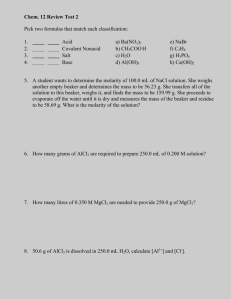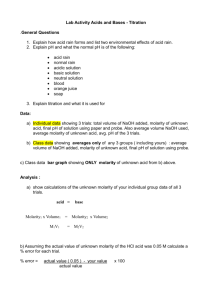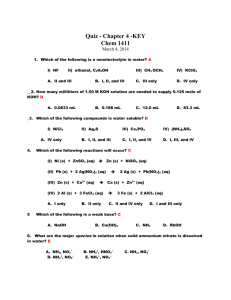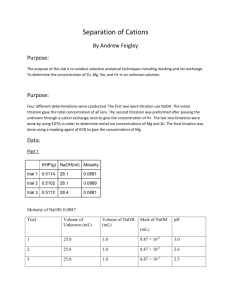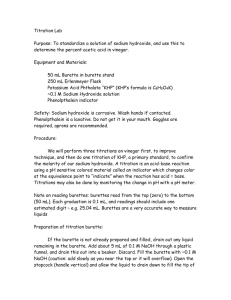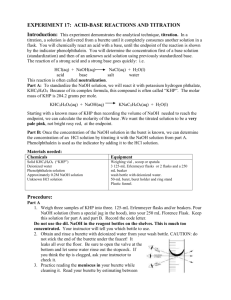acetic-acid-lab-2
advertisement
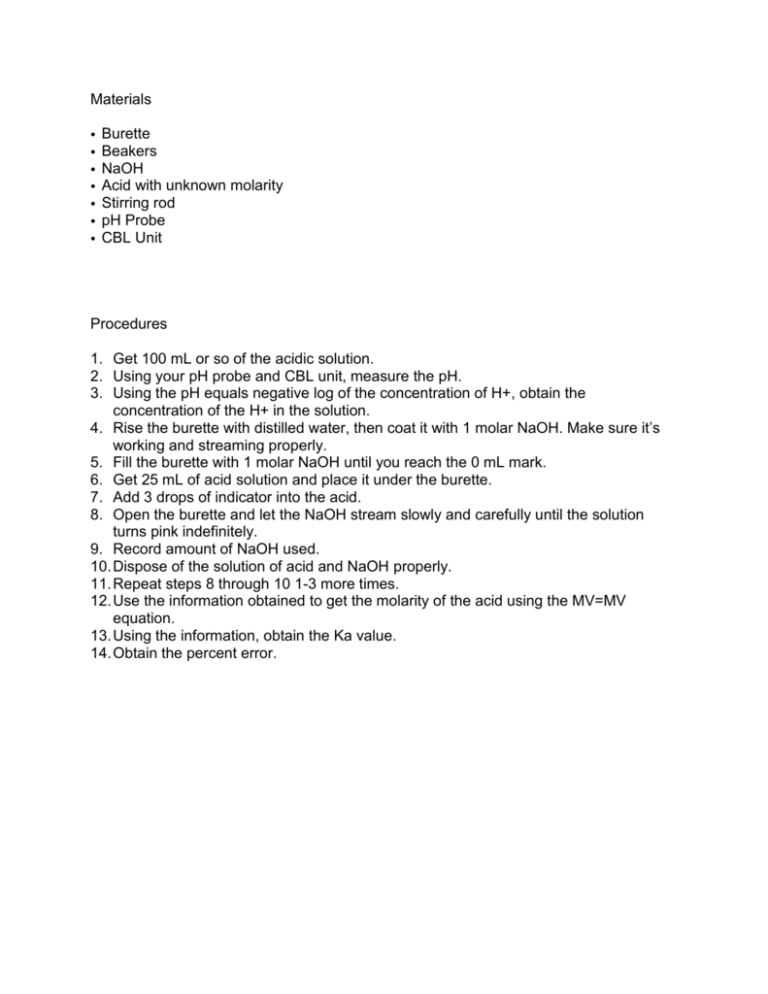
Materials • • • • • • • Burette Beakers NaOH Acid with unknown molarity Stirring rod pH Probe CBL Unit Procedures 1. Get 100 mL or so of the acidic solution. 2. Using your pH probe and CBL unit, measure the pH. 3. Using the pH equals negative log of the concentration of H+, obtain the concentration of the H+ in the solution. 4. Rise the burette with distilled water, then coat it with 1 molar NaOH. Make sure it’s working and streaming properly. 5. Fill the burette with 1 molar NaOH until you reach the 0 mL mark. 6. Get 25 mL of acid solution and place it under the burette. 7. Add 3 drops of indicator into the acid. 8. Open the burette and let the NaOH stream slowly and carefully until the solution turns pink indefinitely. 9. Record amount of NaOH used. 10. Dispose of the solution of acid and NaOH properly. 11. Repeat steps 8 through 10 1-3 more times. 12. Use the information obtained to get the molarity of the acid using the MV=MV equation. 13. Using the information, obtain the Ka value. 14. Obtain the percent error. Conclusion Throughout this lab, we tested a solution of acetic acid with an unknown molarity to find its molarity and Ka value. We got some of this acid “A” and tested its pH using a pH probe and a CBL unit. We got the pH to be 2.57. Using that number and knowing that a pH= - log of the concentration of H+, the concentration of Hydrogen ions was found to be .00269 M. After this, we got 25 mL of acetic acid and placed it under a burette filled with NaOH, a base, of 1 molar. We put 3 drops of indicator in the acid solution and opened the burette. We let the NaOH go into the acid solution until it turned completely pink at which point we knew we had reached the equivalence point.In the first trial, we had to pour 23.2 mL of NaOH for the solution to turn completely pink and remain so. In the second trial, being even more careful as it approached the 22 mL mark, we used 22.8 mL for the solution to turn pink (also using 25 mL of acid). The average being 23 mL, we plugged that into the MV=MV equation and knowing that the NaOH had a molarity of 1 and we had 25 mL of acid, we solved for the molarity of the acid. It came out to be a .92 M HC2H3O2. Knowing that the molarity of HC2H3O2 was .92 M and the molarity of H+ was .00269, we put it into the Ka equation (Ka= [H+][C2H3O2-]/[HC2H3O2]) also knowing that [H+]=[C2H3O2-]. The Ka obtained was 7.9 x 10^-6. The percent error was 43.8% assuming that the accepted value was 1.8 x 10^-5. However, this Ka value is specific for solutions at 25 degrees celsius. Because this solution was most likely not at 25 degrees, knowing that the room temperature was lower, the substantial percent error can be accounted for in that manner. For future labs, one might record the temperature as well; look for the Ka according to that temperature, and then calculate the percent error using that “accepted value”, which unlike 1.8 x 10^-5 would actually be true. Acetic Acid Lab By Amanda Epstein Period 4 March 5, 2009
